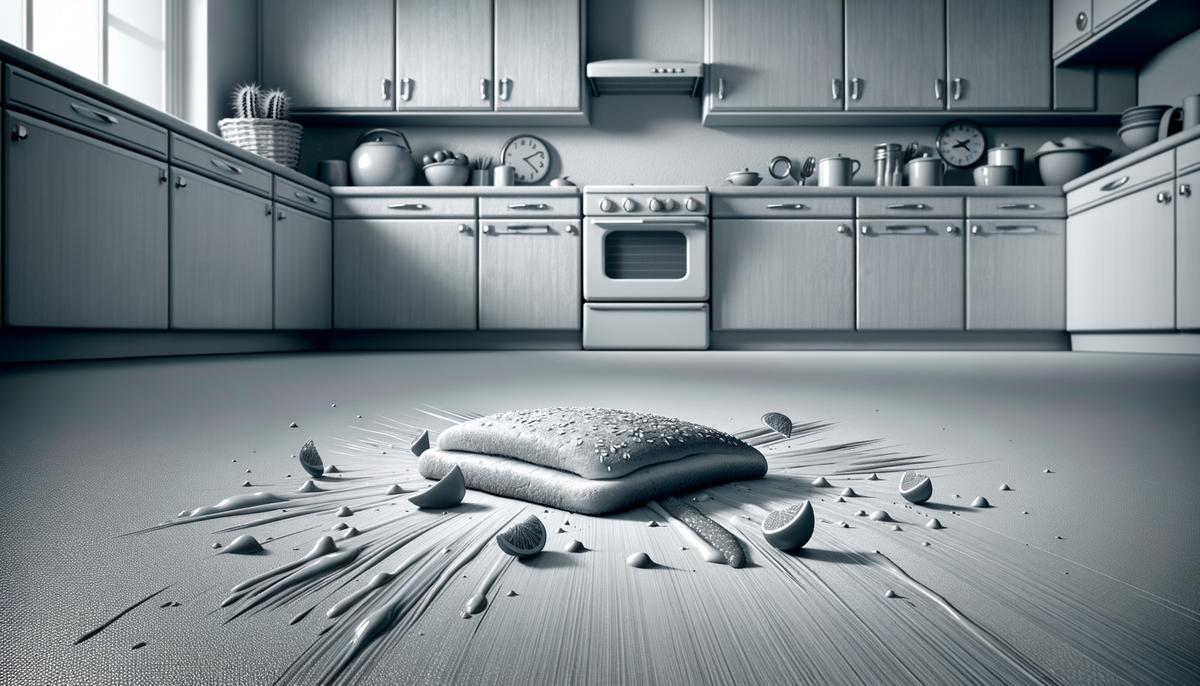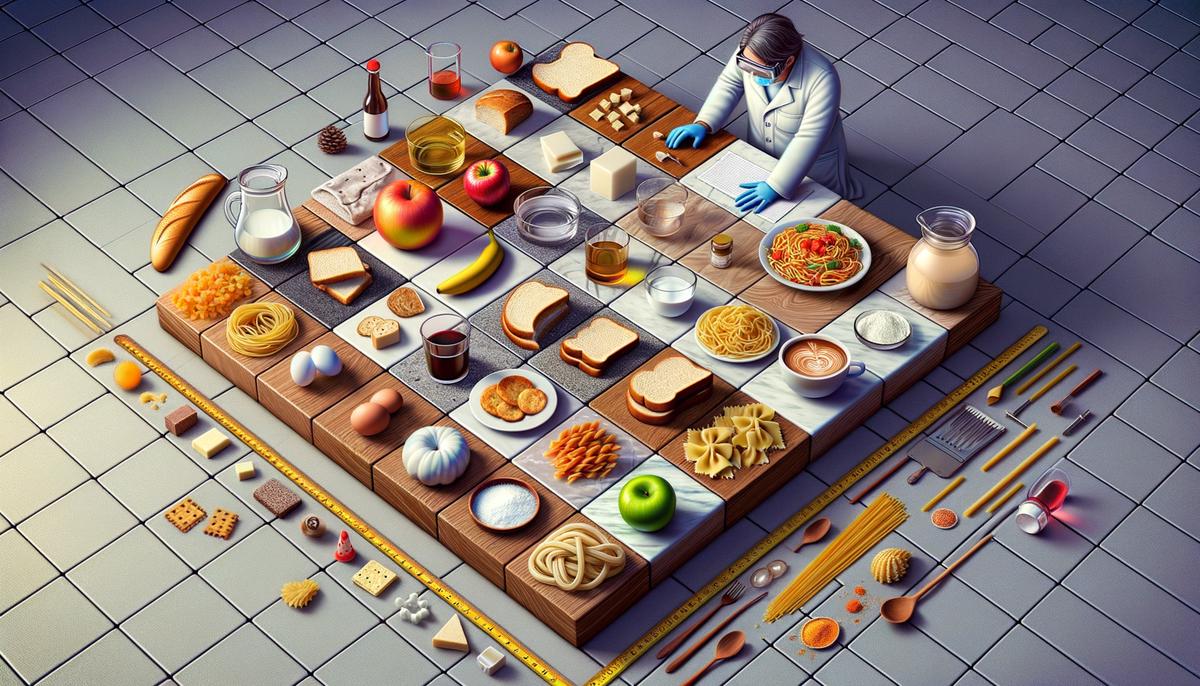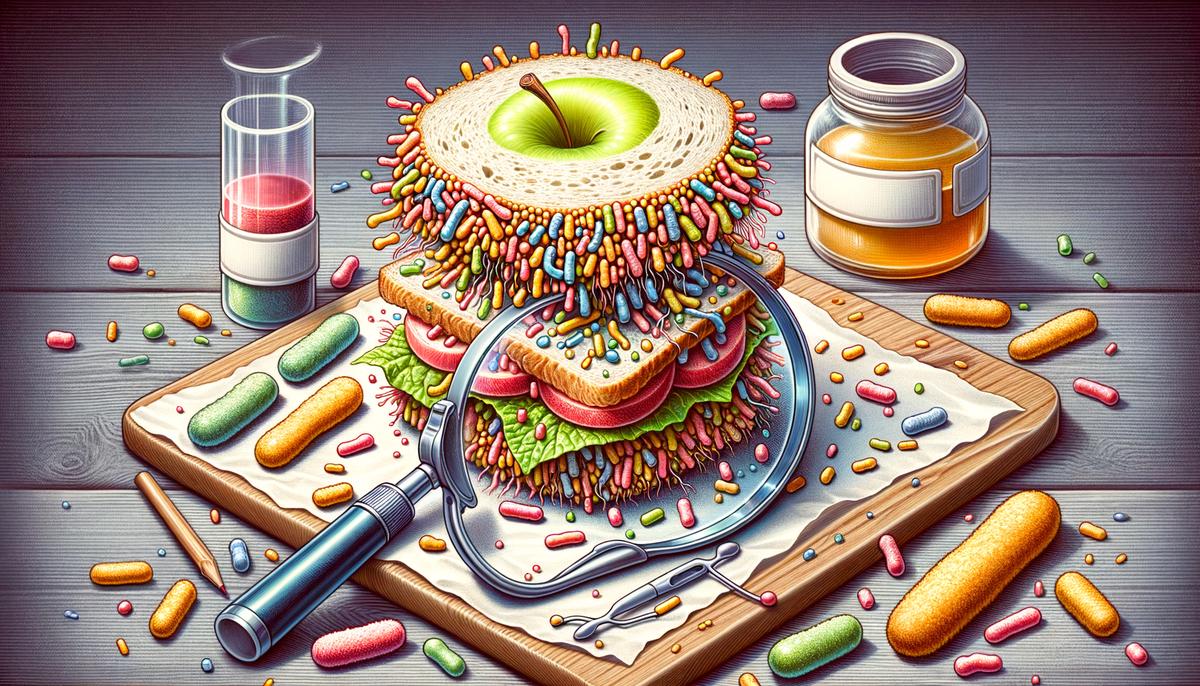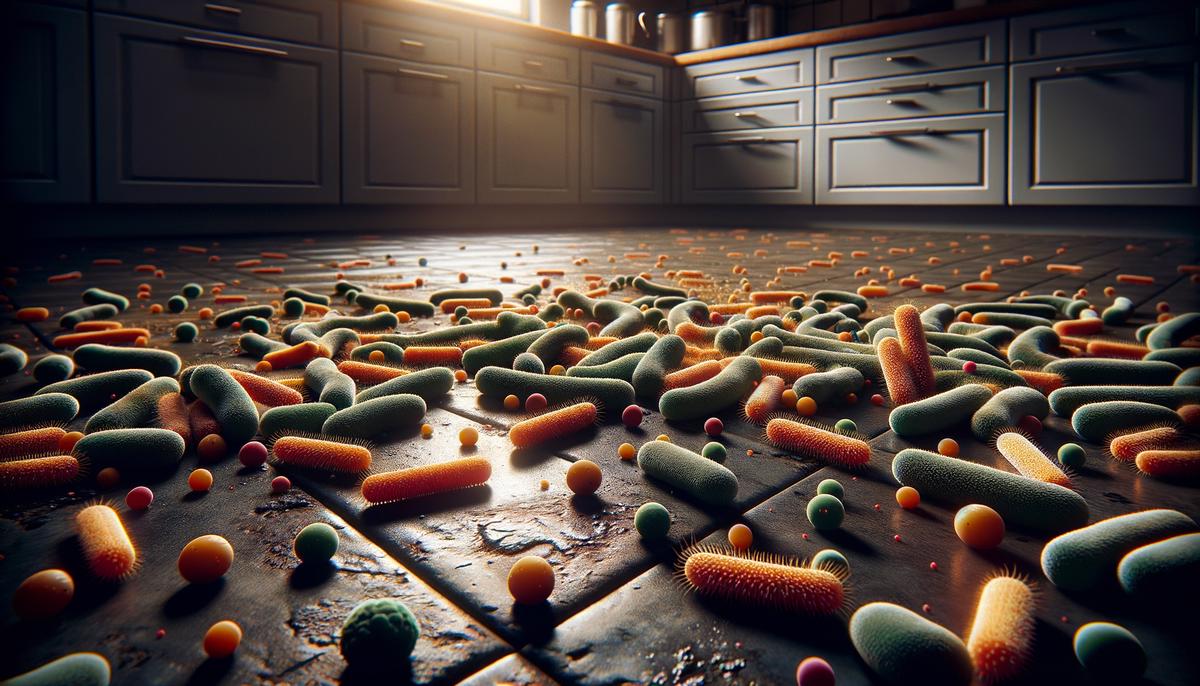Have you ever dropped your favorite snack on the floor and quickly picked it up, claiming the five-second rule? This idea, that food is still good to eat if it’s picked up within five seconds of hitting the ground, is something many of us have heard since we were kids. But where did this rule come from, and is there any real science behind it? Let’s take a closer look at the origins of the five-second rule, explore what research says about it, and consider how our habits around dropped food reflect broader attitudes towards cleanliness and waste.
Origins of the Five-Second Rule
The five-second rule is a popular idea suggesting that food dropped on the floor for less than five seconds is still “clean” enough to eat. But where did this rule come from, and is there any truth to it?
Tracing the origins of the five-second rule takes us back in time, but not to any single moment or scientific study. Instead, it seems this rule emerged from a combination of folklore and common sense. There isn’t a clear point in history when the five-second rule first appeared. Some suggest it might have roots in the Genghis Khan rule, where the Mongolian ruler supposedly declared that food could sit on the floor for a brief period without becoming contaminated. This idea, however, applied to his banquets, assuming that the grandeur of his feast meant food was too good to waste, regardless of a little dirt.
Fast-forwarding to modern times, the five-second rule lives on, more as a shared cultural habit than a scientifically-backed guideline. Various studies have attempted to test its validity with mixed results. Most research concludes that contamination depends more on the food and the floor’s cleanliness rather than the duration it spends on the ground. Moist foods attract more bacteria faster than dry foods, and bacteria can attach to food instantly upon contact with the floor. However, since these studies often look at extreme cases or specific conditions, many people continue to cite the five-second rule as a quick-and-dirty guideline for everyday spills.
Academically, the rule has been the focus of few studies. One of the most cited works comes from high school student Jillian Clarke during a summer internship at the University of Illinois in 2003. Clarke’s experiment found that cookies and gummy bears picked up bacteria after sitting on a contaminated surface, regardless of how quickly they were picked up—challenging the five-second right. Despite its simplicity, this study highlights an essential point: Time may not be as critical a factor as we think when it comes to food contamination.
The five-second rule’s endurance in popular culture likely says more about our tolerance for risk and waste than about science. In a society that increasingly prioritizes hygiene, the idea of eating something off the floor may sound reckless. Yet, the quick decision-making process behind the rule reflects an intuitive cost-benefit analysis—weighing the desire not to waste food against the perceived risk of eating something slightly dirty.
While the five-second rule might not stand up to scientific scrutiny, it endures as a piece of cultural wisdom passed down through generations. Its origins may be murky, and its validity questionable, but as a quick mental shortcut for deciding whether to eat that piece of dropped food, the five-second rule likely isn’t going anywhere soon. In rooms across the world, from bustling kitchens to quiet studies, it continues to spark debate, laughter, and sometimes, a little bit of culinary rebellion.

Scientific Investigations
Turning the lens towards the practical aspect of the five-second rule brings us directly into the heart of the kitchen – and the labs. One of the most notable studies that pushed the boundaries of our knowledge about the five-second rule was conducted by researchers at Rutgers University in 2016. Led by Professor Donald Schaffner, the team embarked on an ambitious project to explore how different factors, such as surface type, food nature, and contact duration, influence bacterial transfer.
The comprehensive study by Rutgers utilized four surfaces: stainless steel, ceramic tile, wood, and carpet. These surfaces were exposed to Enterobacter aerogenes, a bacteria representative of the risk from Salmonella – though less hazardous. The researchers experimented with watermelon, bread, bread with butter, and gummy candy, examining the impact of contact times ranging from less than one second to over five seconds.
What the Rutgers study unfolded might sour some stomachs. The results showed that moisture played a crucial role in bacterial transfer, making watermelon the most susceptible to contamination. Surprisingly, the type of surface also had a significant impact, with carpet being less likely to transmit bacteria compared to tile and stainless steel. Yet, even the briefest contact of less than one second was enough for bacteria to leap from surface to snack, discrediting the notion that speed is a safeguard against germs.
Further delving into this topic, another study by Aston University’s Anthony Hilton and his team in 2014 took a slightly different track. They too examined the transfer of common bacteria such as Escherichia coli and Staphylococcus aureus from various floors to toast, pasta, and sticky sweets. They found time does indeed factor into bacterial transfer but also reiterated that the type of food and surface plays a significant role. Drier foods and less bacteria-harboring surfaces like carpet provided a smidge more grace than their counterparts.
These scientific endeavors reveal a mosaic of findings that paint a more nuanced picture of the five-second rule than previously thought. It becomes clear that while the rule might hold a kernel of truth under specific conditions, relying on it as a universal safety measure is flawed. Food safety, as pointed out by these studies, is not just a matter of time but involves a complex interplay of factors including the type of food, the surface it falls on, and the inherent risk of the bacteria present.
Therefore, while the five-second rule might survive in cultural lore and domestic practices, it stands on shaky ground scientifically. As our collective knowledge grows and more studies like those conducted by Rutgers and Aston Universities serve enlightening insights, it might be high time to view the five-second rule less as a fact and more as folklore with a footnote of caution. In the grand scheme of things, it underscores a fundamental truth: when it comes to food safety, erring on the side of caution is perhaps the wisest rule to follow.

Bacteria and Contamination
In the realm of food safety, understanding how bacteria transfer to food is more than just a matter of scientific curiosity—it’s crucial for maintaining health. Despite existing guidelines and food safety measures, bacteria find myriad routes to make their way onto our plates. Let’s explore the most common pathways through which bacteria contaminate food, keeping in mind the underlying factors that can exacerbate or mitigate this process.
Handling and Preparation Environment:
First and foremost, the cleanliness of the hands and surfaces in direct contact with food plays a pivotal role. Kitchens and food prep areas are battlegrounds where the fight against bacterial invasion is either won or lost. Countertops, cutting boards, and kitchen tools can harbor bacteria if not properly sanitized before and after use. Similarly, our hands are constant carriers of microbes, emphasizing the importance of thorough washing before handling food.
Raw Foods Cross-Contamination:
Raw foods, particularly meats, poultry, and seafood, can be teeming with bacteria such as Salmonella and E. coli. When these raw foods come into contact with ready-to-eat items or surfaces used for other foods without adequate cleaning in between, cross-contamination occurs. It’s not just about keeping these items separate; ensuring that juices from raw meats don’t find their way onto other foods or utensils is crucial.
Improper Cooking and Storage Temperature:
Bacteria thrive within certain temperature ranges, with the so-called “Danger Zone” between 40°F and 140°F being particularly conducive to bacterial growth. Food that isn’t cooked to the correct internal temperature or left at unsafe temperatures post-cooking offers a welcoming environment for bacteria. Furthermore, improperly cooled foods or those left out too long before refrigeration invite bacterial proliferation that can easily transfer to whoever consumes them.
Water and Produce:
The way produce is washed (or not washed) can also impact bacterial presence. Water contaminated with bacteria can easily transfer these microorganisms onto fruits and vegetables. Since many produce items are consumed raw, any bacteria present won’t be killed by cooking. This makes proper washing under safe, clean tap water an essential step in reducing the risk of bacterial transfer.
Packaging and Transportation:
Even before food reaches our kitchens, its packaging and the conditions under which it’s transported play roles in its safety. Damaged packaging can expose food to harmful bacteria during transit, storage, or while on display in stores. Additionally, foods transported or stored at incorrect temperatures may already be compromised before they enter a consumer’s kitchen.
Personal Contact and Animal Interaction:
Lastly, indirect transfer of bacteria from person to person or through pets and pests can end up contaminating food. Activities like coughing or sneezing near food, or pests such as flies and rodents coming into contact with food surfaces, underscore the need for vigilance.
Protecting food from bacterial transfer is an ongoing process that starts long before the food reaches our plate and doesn’t end until we’ve safely consumed it. From ensuring proper hygiene in handling and preparing food to understanding the conditions that foster bacterial growth and spread, every step taken is a move towards safer eating practices. Given the complexity of our food systems and the ease with which bacteria can move through it, ensuring food safety is an essential, though often unseen, part of our daily lives.

Psychological Aspects
Despite the extensive dialogue on the perils and precautions surrounding food contamination, there remains a seamless thread linking these narratives with the inherently human trait of convenience-seeking behavior, manifesting robustly in the adoption of the five-second rule. Amidst the stride towards understanding and mitigating contamination risks, it becomes imperative to scrutinize the psychological underpinnings that fuel the persistence of this rule in public consciousness.
The human inclination towards minimizing waste, juxtaposed with the instinctual desire not to dismiss moderately soiled food, propels the five-second rule into the realm of widespread social acceptability. This amalgamation of frugality and practicality serves not only as a testament to human adaptability but also as a critique of the evolving societal norms concerning food consumption and hygiene.
Furthermore, the perceived immediacy of picking up fallen food supplements an illusion of control over an unpredictable contamination process,. This immediate action suggests a visceral response, hinged not on empirical evidence but on the quick assessments and risk evaluations performed subconsciously by individuals. In parallel, the subtext of personal hygiene practices comes to fore, subtly indicating that adherence to the five-second guideline might also mirror an individual’s broader outlook towards cleanliness and sanitation within their immediate environment.
In an era marked by rapid access to information, including research debunking the rule’s reliability, it becomes paradoxical to witness its continued prevalence. This paradox not only sheds light on the inherent resistance within societal constructs to relinquish folklore or myth in favor of scientific advice but also highlights an overarching tendency towards clinging to practices rooted in anecdotal experiences or inherited familial wisdom.
Contrastingly, the journey of information dissemination and the mechanisms through which scientific understandings permeate popular culture wield profound implications on dietary habits and safety perceptions. As individuals navigate through this meshwork of cultural narratives and scientific discoveries, the fidelity towards inherited wisdom like the five-second rule underscores a broader conversation about trust, knowledge acquisition, and the readiness to recalibrate behaviors in light of new evidence.
In dissecting the layers that contribute to the endurance of the five-second rule within cultural paradigms, one encounters a complex interplay of psychology, societal habits, and collective memory. This interplay, while seemingly innocuous in the context of dropping food, reveals substrates of human behavior and societal constructs that transcend the act itself, indicating a broader canvas of human nature’s dalliance with risk, hygiene, and the paradoxes therein.

Public Health Perspectives
Public health experts emphasize that while the five-second rule might be a popular myth, sticking strictly to it can pose real health risks. Despite various studies, including those by Rutgers and Aston University, showing the rapidity with which bacteria can transfer to food once it hits the floor, people continue to use the rule as a guideline for what’s safe to eat. However, experts warn that such practices overlook the nuanced complexity of how bacteria move and live, not to mention how diverse they are in terms of what can make us sick.
What often gets lost in translation between scientific studies and everyday practices is the sheer variety of bacteria and other pathogens that exist in our environments. Not all bacteria cause diseases, but those that do can adhere to and contaminate food in a matter of seconds, contradicting the assumed safety vetted by the five-second rule. Public health officials point out that E. coli and Salmonella, two common culprits of foodborne illnesses, can transfer almost instantaneously upon contact with a surface.
Another overlooked aspect is the microenvironments in our homes, such as kitchen floors, countertops, and pet areas, which can harbor different kinds of bacteria. The kind of surface, humidity, and food composition can drastically affect bacterial transfer rates, making it nearly impossible to gauge safety through a simple timeframe. For example, moist foods dropped on a tiled kitchen floor may pick up bacteria more readily than dry foods dropped on a carpeted surface. Yet, the rule does not differentiate between these conditions, painting an overly simplistic picture of what is essentially a complex biological exchange.
Public health advice tends to err on the side of caution. Experts stress the importance of maintaining clean cooking and eating spaces, washing hands regularly, and treating perishable foods with care to limit exposure to potential pathogens. They highlight the point that prevention is always better than the cure, underscoring the need to avoid food-to-floor contact altogether, rather than relying on luck.
Additionally, experts draw attention to the broader implications of assuming food that has contacted the floor for less than five seconds is safe. This perspective can lead to underestimating the real dangers of cross-contamination in more high-risk scenarios, such as raw meats or unwashed vegetables coming into contact with ready-to-eat foods. Such habits may cultivate a lax attitude toward food hygiene, which could heighten the risk of foodborne illnesses that affect millions annually.
In summary, while the five-second rule may offer a sense of security and justification for salvaging dropped foods, public health experts consistently emphasize that it should not guide food safety practices. The tiny window of time offers no real barrier against bacteria ready to make a leap from floor to food. Instead, adopting stringent food safety habits — treating all dropped foods as potential health risks, maintaining clean kitchen spaces, and practicing personal hygiene — are advised to significantly reduce the risk of foodborne illnesses. Given the potential health implications involved, erring on the side of precaution seems a small price to pay for safety.

Alternative Views and Practices
With the extensive overview of the five-second rule already outlined, including its origins, scientific studies, and implications for food safety, it becomes clear that this popular belief is fraught with misconceptions. However, beyond the heavily scrutinized five-second rule, what other alternative views or practices exist regarding dropped food?
Interestingly, cultures around the world have developed their unique responses to the accidental tumbling of edibles. For instance, some households adopt a more conservative “zero-second rule,” operating under the principle that once food touches the floor, it is immediately considered contaminated and unfit for consumption. This stringent approach underscores a heightened awareness of hygiene and the risks associated with even transient contact with potentially dirty surfaces.
In contrast, others may rely more heavily on the cleanliness of their flooring, particularly in spaces where shoes are traditionally removed, such as in many Asian households. Here, the floor is often kept meticulously clean, which might influence a slightly more lenient attitude towards briefly dropped food. However, even within these environments, the decision to consume dropped food is informed by visible contamination and the nature of the food item itself—moist or sticky foods being more prone to bacteria hitchhiking off the floor.
On a more scientific note, there’s a push for better education on the specific factors that affect bacterial transfer, a nuanced understanding that goes beyond time alone. The conversation shifts from a simple time-based rule to a broader comprehension of context—surface cleanliness, food moisture, and the type of microorganisms present in the environment.
Moreover, professional kitchens offer a glimpse into stricter procedures where dropped food is concerned. In these settings, adherence to health codes and regulations often dictates a no-tolerance policy for floor contact, underscoring the priority of consumer safety over food waste. This professional stance highlights the critical balance between minimizing waste and ensuring safe eating practices.
In educational contexts, some programs aim to demystify scientific concepts related to bacteria and contamination through interactive experiments reminiscent of Jillian Clarke’s iconic study. Such initiatives help bridge the gap between scientific knowledge and everyday practices, encouraging more informed decisions about food safety at all ages.
Lastly, technological advancements contribute an interesting twist to traditional debates on dropped food. Innovations in floor cleaning devices and disinfection methods have made cleaner surfaces more attainable for the average household. Nonetheless, even the most sophisticated technology cannot guarantee absolute cleanliness, reinforcing the notion that when it comes to dropped food, erring on the side of caution remains advisable.
Altogether, while the five-second rule persists in public consciousness, alternative views and practices reflect a spectrum of attitudes towards dropped food. From stringent rejection to culturally informed leniency, these diverse reactions to a common occurrence underline the complex interplay between culture, knowledge, and individual judgment in our relationship with food and cleanliness.

As we’ve explored the various facets of the five-second rule—from its murky historical origins to modern scientific scrutiny—it’s clear that this piece of cultural wisdom holds more significance as a reflection of human behavior than as a guideline for food safety. The enduring popularity of the five-second rule speaks volumes about our collective willingness to balance risk with practicality. Yet, in lightening our approach to dropped food with humor and a bit of rebellion against strict hygiene norms, we also open doors for conversations about safer eating practices. Ultimately, while science may debunk its validity as a hard-and-fast rule, its presence in our lives underscores an ongoing dialogue between tradition and knowledge—a reminder that sometimes common sense and caution are our best guides.
Experience the power of AI writing with Writio! This page was generated by Writio.
Leave a Reply